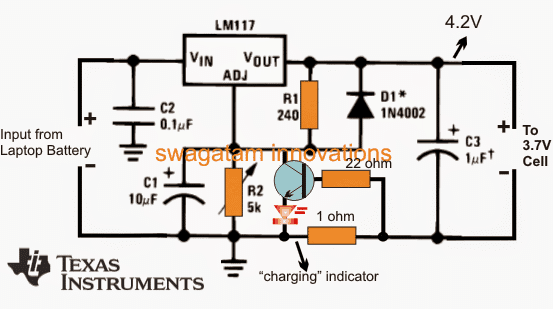The post presents a simple circuit that may be used for charging a cellphone battery with a laptop battery. The idea was requested by Mr. Gyashuddin.
Recharging Cellphone Battery with Laptop Battery
hello sir my self md gyashuddin I want to know that it is passible to built a circuit which can ,recharge my cell phone battery from full charged my laptop battery.
If yes can you help me for this. I have : a laptop battery 10.8 V -- 48Wh(approx. 4444.4 mAh) and a mobile battery 3.7V -- 1450mAh In other word i want a adapter that recharge my cell battery from dc source ie my laptop battery my english is not good sir In simple word can i use my laptop battery as power backup for 3.7V cell phone battery Thanking you
Solving the Circuit Idea
Hello Mohammad, yes it's possible, just build a LM317 voltage regulator circuit, adjust its pot for getting 4.2V at the output, ........that's all...now you can connect the 10V to the input of the circuit and the 3.7V cell across the output of the circuit for fast charging it.
The detailed circuit regarding charging a cellphone battery with a laptop battery can be studied below:
Circuit Diagram

The value of R2 could be calculated either through this calculator software or using the following formula:
VO = VREF (1 + R2 / R1) + (IADJ × R2)
where VREF = 1.25
The IADJ could be eliminated since it's too small to be considered in most cases.
LED Function
The shown LED will shut of when the 3.7V cell is almost fully charged.
Caution: Switch off the power to the 3.7V cell as soon as the red LED begins shutting off, in order to prevent the cell from over charging and damage.
For ensuring better safety you may want to set the output voltage to 3.9V, although this could mean the cell getting charged only upto 80% and not upto the optimal point.
For implementing an automatic cut-off you can try this automatic battery charger circuit concept
can 5v input be used for the regulator so that 1.25Vref and output be 4.85V.`thanks in advance
The input has to be at least 6 to 7V, 5V might not work correctly.
can it be use to charge mobile phone directly sir?
yes it can be used….you can also employ the following deign for an auto cut off
https://www.homemade-circuits.com/2012/02/how-to-build-automatic-6-volt-12-volt.html
great one